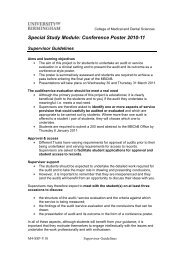Contents - College of Medical and Dental Sciences - University of ...
Contents - College of Medical and Dental Sciences - University of ...
Contents - College of Medical and Dental Sciences - University of ...
You also want an ePaper? Increase the reach of your titles
YUMPU automatically turns print PDFs into web optimized ePapers that Google loves.
The 11 th International Workshop on KSHV & Related Agents, Birmingham, UK<br />
Poster Session Abstract P12<br />
THE M TYPE K15 PROTEIN OF KAPOSI'S SARCOMA-ASSOCIATED HERPESVIRUS<br />
INDUCES CELL MIGRATION, INVASION AND REGULATES MICRORNA<br />
EXPRESSION VIA ITS SH2-BINDING MOTIF<br />
Yu-Hsuan Wu 1 , Min-Fen Wu 1 , Yuan-Hau Tsai 1 , Su-Fang Lin 3 , Tyson V. Sharp 4 <strong>and</strong> Hsei-<br />
Wei Wang 1,2,5<br />
1 Institute <strong>of</strong> Microbiology <strong>and</strong> Immunology, 2 Institute <strong>of</strong> Clinical Medicine, National Yang-<br />
Ming <strong>University</strong>; 3 Division <strong>of</strong> Clinical Research, National Health Research Institute,<br />
Taiwan; 4 School <strong>of</strong> Biomedical <strong>Sciences</strong>, <strong>University</strong> <strong>of</strong> Nottingham <strong>Medical</strong> School,<br />
Queen’s <strong>Medical</strong> Centre, Nottingham, UK; 5 Department <strong>of</strong> Teaching <strong>and</strong> Research,Taipei<br />
City Hospital, Taipei, Taiwan<br />
Abstract<br />
Kaposi’s sarcoma (KS) associated herpesvirus (KSHV) is the etiological agent <strong>of</strong> KS. In<br />
vivo KS is a tumor capable <strong>of</strong> spreading throughout the body, <strong>and</strong> pulmonary metastasis<br />
is observed clinically. In vitro KSHV induces the invasiveness <strong>of</strong> endothelial cells.<br />
However, no viral gene has yet been implicated in cell invasion. The KSHV ORF K15 is a<br />
KSHV-specific gene encoding a transmembrane protein. Two highly divergent forms <strong>of</strong><br />
K15, the predominant (P) <strong>and</strong> minor (M) forms (K15P <strong>and</strong> K15M, respectively) have been<br />
identified in different KSHV strains. K15 resembles the LMP2A gene <strong>of</strong> Epstein-Barr virus<br />
(EBV) in their genomic locations <strong>and</strong> protein topology. Also, both K15 proteins have<br />
similar motifs to those found in EBV LMP1 protein. K15 therefore appears to be a hybrid<br />
<strong>of</strong> a distant evolutionary relative <strong>of</strong> both EBV LMP1 <strong>and</strong> 2A. Since both LMP1 <strong>and</strong> LMP2A<br />
proteins are capable <strong>of</strong> inducing cell motility <strong>and</strong> have been linked to NPC metastasis, we<br />
questioned whether K15 also possesses similar abilities. In this study, we show by the<br />
use <strong>of</strong> a K15M-specific mAb <strong>and</strong> PCR, that K15M is latently expressed in KSHV positive<br />
PEL cells. K15M localizes on lysosomal membrane <strong>and</strong> is capable <strong>of</strong> activating the NF-kB<br />
transcription factor via its SH2-binding motif. K15M induces cell migration, invasion <strong>and</strong><br />
the expression <strong>of</strong> microRNAs miR-21 <strong>and</strong> miR-31 via this conserved motif. K15M<br />
therefore may contribute to KSHV-mediated tumor metastasis <strong>and</strong> angiogenesis.<br />
Targeting <strong>of</strong> K15 proteins or their downstream micorRNAs for therapy may represent a<br />
novel avenue <strong>of</strong> treatment for KSHV-associated neoplasia.<br />
Presenting author Email: b881625@life.nthu.edu.tw<br />
109















